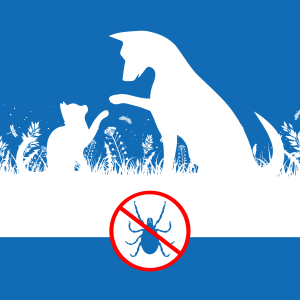
How can I protect my pets?
Pets are at risk for tick bites and tick-borne diseases too, particularly as they tend to run off leash and in vegetation. Lyme disease poses a risk to dogs, whereas it is extremely unlikely to occur in cats. Anaplasmosis is the second most common disease spread by blacklegged ticks and can affect dogs, cats, and horses, as well as humans.
Can my dog give me Lyme disease ?
Pets are not able to transmit Lyme disease to humans. Having a pet has been associated with an increased risk of tick bites or disease transmitted by ticks in their owners. This is usually because having a pet means you spend more time outdoors and in proximity to ticks. It does not mean you should avoid having pets! If you see ticks on your pet, this suggests that you may be exposed to ticks outdoors and that you should take steps to protect both you, your pet(s), and your family.
Tick control products
There are many options available for dogs and cats, which are applied and work differently. Several products will protect your pet against other parasites too. Speak to your veterinarian to understand which product will suit you and your pet best, depending on where you live, your lifestyle, and your pet.
There is a Lyme disease vaccine available for dogs – speak to your veterinarian to find out if this is something that would benefit you and your dog.

Staying on trails
By keeping your animal on paths and trails, and away from long grass, brush and leaf litter, you can minimise the chance of them acquiring ticks.
Similarly, there are measures you can take to reduce tick exposure on your property. For more information, check out ‘What can I do to reduce ticks in my yard?’.

Daily tick check
In much the same way as we should check ourselves for ticks, performing a tick check at least once per day on your pets helps keep them safe and may reduce the chance of ticks being brought into the home.
This can be tricky if your pet has long or thick hair but do the best you can to check all over your pet, including the paws, legs, belly and head, and enjoy this time with your pet!
Ticks can be removed with fine-tipped tweezers or a tick puller device. Having someone with you to hold and distract your pet may be helpful. For information on how to remove a tick, visit ‘What should I do if I find a tick?‘.
If you are at all concerned about identifying or removing a tick, risk of disease, symptoms, or what to monitor for, contact your veterinarian. You can also submit photos of the tick for identification to eTick.

It is not always straight forward…
In some cases, these prevention measures may not be feasible. It is then even more important to consistently apply tick control products to your pet, according to the label. Speak to your veterinarian to understand which products will best suit your needs.
For more information about ticks and your pets, you can explore Tick Talk, a website developed by the Canadian Veterinary Medical Association.

Cover photo by: MolnarSzabolcsErdely via Pixabay